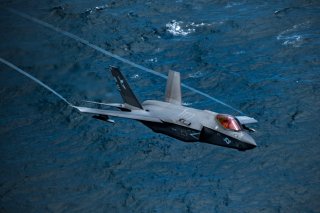QUICKSINK: The Air Force Will Soon Be Destroying Ships from Above
While submarine-delivered torpedoes are one of the primary systems designed for sinking ships, new methods explored by the QUICKSINK program may achieve anti-ship lethality with air-launched weapons.
An Air Force F-15E Strike Eagle destroyed a “full-scale” surface vessel in the Gulf of Mexico during a demonstration of a cutting-edge Pentagon weapon that is able to target and destroy moving ships at sea, a development that may introduce new attack options for U.S. commanders. Under the auspices of the QUICKSINK program, the United States fired a precision-guided GBU-31 joint direct attack munition (JDAM) at the surface ship as part of what’s called a joint capability technology demonstration.
Some of the particulars related to the guidance systems of the weapon were not available in the report, but an ability to attack with air-dropped, precision-guided JDAMs against a moving ship is a substantial step forward in the realm of maritime combat, according to a recent Air Force report.
While submarine-delivered torpedoes are one of the primary systems designed for sinking ships, new methods explored by the QUICKSINK program may achieve anti-ship lethality with air-launched weapons, including modified 2,000-pound JDAM precision-guided bombs, the Air Force report said.
“Heavy-weight torpedoes are effective [at sinking large ships] but are expensive and employed by a small portion of naval assets,” said Maj. Andrew Swanson, chief of advanced programs for the 85th Test and Evaluation Squadron. “With QUICKSINK, we have demonstrated a low-cost and more agile solution that has the potential to be employed by the majority of Air Force combat aircraft, providing combatant commanders and warfighters with more options.”
The Air Force report is also clear that in addition to enabling aerial attacks on moving surface ships, QUICKSINK greatly expands the scope of anti-ship operations, particularly when compared with torpedo fire.
Air Force Research Lab scientists appear to have modified an existing JDAM to enable it to strike and destroy moving ship targets, which fully aligns with the Air Force report’s discussion of a Weapon Open Systems Architecture development strategy (WOSA). WOSA refers to the use of common internet protocol and technical standards engineered to smoothly accommodate and integrate emerging technologies as they become available. For example, software upgrades can improve the guidance functionality of the weapon or expand its targeting or explosive effects. This modification strategy can be massively expedited through the use of a common, interoperable technical infrastructure capable of quickly integrating adaptations.
As a joint Air Force-Navy effort, it would not be surprising if the U.S. Navy were to quickly integrate this technology into carrier- and amphibious-launched platforms like the F/A-18 Super Hornet or even F-35Cs and F-35Bs. Software upgrades and technological adjustments could also better enable the Pentagon’s highly sought-after multi-domain connectivity effort, which is intended to link fighter jets with drones, surface ships, and other air assets in real-time in order to share target information and quickly expedite attacks on moving targets.
Kris Osborn is the Defense Editor for the National Interest. Osborn previously served at the Pentagon as a Highly Qualified Expert with the Office of the Assistant Secretary of the Army—Acquisition, Logistics & Technology. Osborn has also worked as an anchor and on-air military specialist at national TV networks. He has appeared as a guest military expert on Fox News, MSNBC, The Military Channel, and The History Channel. He also has a Master’s Degree in Comparative Literature from Columbia University.
Image: Flickr/U.S. Navy.

